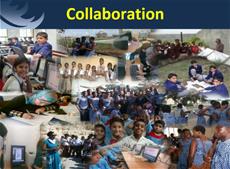One of the many schools around the world that have inspired me and caused me to think more deeply about how we achieve personalisation is the Daanish School Chishtian Boys Campus which is part of an innovative education project started in 2011 by the Government of Punjab in Pakistan

The school describes itself as a ‘Heaven for Underpriviledged and Unrecognised’. It accepts students from a wide catchment on the basis of need. Every student is there through an individual and fairly unique set of circumstances and the school's mission is to meet each of these complex needs to the best of its ability. Whereas an increasing number of schools in the world select on the basis of wealth, ability or class, Daanish’s admissions policy offers admissions exclusively to the following categories of student;
- Students who’s parents are illiterate
- Students who’s parents are without a fixed address or employment
- Students from families with a combined income of less than $2 a day
- Orphaned/double orphaned students
- Disabled students and those of disabled parents
- Students who’s parents are illiterate and are living in KATCHA (constructed with mud) house
The success of the school since its inception is quite astounding both in terms of the achievements of its students but also in terms of the impact on perceptions in the neighbouring areas causing the status of the school to grow exponentially.
Principal of the school, Muhammad Yaseen Mirza, is passionate about education and will take any opportunity to talk continuously about the achievements of the students in his school. Dig underneath this list of successes and you get to what is at the core of his philosophy: He believes that “above all you must give students honour”. In reality this means an ethos of mutual respect rather than an enforced hierarchy. Muhammad Yaseen Mirza expresses this in terms of “sitting with students, giving them praise, placing their pictures on the notice board and badges to recognise their strengths”
Last year, the school aimed to work on the Hot Topic of Personalisation as a pathfinder school in the PiL programme. Students would develop the skills that underpin personalisation. In order to do this they would be given even greater challenges as leaders and co-creators of learning. The list of current projects below gives a clear idea of the scale of the ambition for these students as well as providing some excellent ideas for others to share.

- Students are given trust and responsibility as part of a leadership qualification for part of the grounds of the school, this has already resulted in numerous pleasant green areas that have the feel of a park despite no formal funding for ground staff. This in turn increases the pride in the school from the students and healthy competition for improving this environment.
- Students develop lessons particularly focused on how to use new technology. They deliver these lessons not only to their peers but also to the teachers as students and out to local schools. Follow this link to see a video of this in action.
- Students are given peer coaching responsibilities in which they develop the learning of other students both mentoring them and engaging them in further opportunities
- Students are given opportunities to take the roles traditionally reserved for adults wherever possible and in doing so build the peer respect, role modelling and ambition of all students.
- Praise is used extensively such as in the annual ‘shining stars’ awards as seen on this clip. Like many, I can’t understand the spoken language but can certainly understand the body language of confidence and pride.
- Students present their work and hear about the work of student leaders in other schools through a monthly forum involving 12 schools across the world through the Microsoft PiL coaching teams and 14 Daanish Schools.
- A trickle down model is used to spread training in the use of the Microsoft Learning Suite both within the school and to a range of nearby Government and public institutions. In this model, 15 students are trained by a visiting expert or school based expert, they then each train 15 more and so on until all students have the opportunity to learn and most have the opportunity to teach. Teachers reported that.. “It was a marvelous exercise by Daanish students because host schools and students were completely unaware with these modern approaches and Microsoft learning suit and they learnt it due to the initiative of Daanish students”.
- The trickle down model is also used to develop 21st Century skills. Students act as personal coaches to younger students. To ensure personalisation, the students are prepared to help develop a wide range of skills including self confidence, debating skills, presentation and collaboration skills. For example, the best public speaker would be take responsibility for training others.
Daanish is an excellent example of success in academic achievements that have been driven by a focus on the skills which underpin successful communities. The focus on all the elements of a REORDER strategy including collaboration, leadership, mutual respect and recognition provides the conditions for exceptional progress and achievement. Is it the excellence of teaching, the peer role modelling or the Principal being seen to ‘sit with students’ and recognise their achievement that is the main driver of this success? Like many case study schools it is in the blend of these within a coherent and clear overall vision of learning. A vision of personalisation based on ‘honouring each and every person’
 39
39